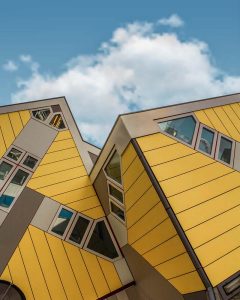[dropcap letter=”R”]
otterdam is the visual antithesis of Holland. A gala village of skyscrapers in the middle of Dutch halcyon. In a country where the heart of cities always looks like a collection of dolls houses, Rotterdam stands proud and disarranged, rising in futuristic concrete and glass towers. Falling in love with her is not a matter of a one night stand, but with the time required, her seaport soul, her good taste and her creative and audacious character leave an imprint that is difficult to forget.

Here, the impossible tends to normal. Arriving at the city by train is like emerging through a gigantic white shark fin. On winter nights, the neighbouring skyscraper is illuminated with tinkling LEDs, painting a starry sky. Next to the old port, there emerges a neighbourhood in the shape of a yellow forest where the treetops are cube-houses, the Kubus Woning. There are towers like balancing Lego bricks—such as Dock21; skyscrapers like the Maastoren heated by the river water; the lollipop-like Euromast, over 100 meters high where you can eat and sleep in the heights and then abseil or zip line back down. There are also bridges like titanic harps that will open up, like the Erasmusbrug, and even covered markets shaped like an aerodynamic dolmen—the , where you can buy fresh fruit while the residents go about their lives in the walls of the building. In 2025, the Dutch Windwheel, a 174-meter round building will emerge from the harbour’s waters with a bladeless wind turbine at its centre, with a restaurant, a hotel, homes, offices, a panorama deck, to become, above all, an icon of Rotterdam that never stops reinventing itself.
THE CITY THAT DREAMED DIFFERENT
On the 12th of May, 1940, Rotterdam was severed from its former identity. A 15-minute bombing with 97,000 kilos of high-explosives destroyed 24,000 homes and 600 years of cobbled streets, gabled buildings and windows facing canals, turning the centre into a sea of rubble where only the Gothic church, the Sint-Laurenskerk remained standing like a lighthouse among the ruins.
 It was an abrupt end to centuries of tradition and decades of modernity. Rotterdam was, between the wars, the capital of espionage and jazz, culture and nightlife. Thinkers, traitors, immigrants, businessmen, artists and scoundrels inhabited its streets until the war stopped time. After the liberation, the city wiped the slate clean and emancipated itself from her destiny. There was no sentimentality: Rotterdam decided to become another. The whole centre was expropriated, levelled and made a blank canvas: not even the layout of the streets was to be respected. Freedom was absolute.
It was an abrupt end to centuries of tradition and decades of modernity. Rotterdam was, between the wars, the capital of espionage and jazz, culture and nightlife. Thinkers, traitors, immigrants, businessmen, artists and scoundrels inhabited its streets until the war stopped time. After the liberation, the city wiped the slate clean and emancipated itself from her destiny. There was no sentimentality: Rotterdam decided to become another. The whole centre was expropriated, levelled and made a blank canvas: not even the layout of the streets was to be respected. Freedom was absolute.
Rotterdam made up for the loss of her identity with the development of a new personality: the werk stad or “working city”. And with the thrust of the pride in the reconstruction, the city progressed through the decades as did the great American metropolises: between the lights of architectural landmarks and the shadows of crime and drugs. But by the second decade of the second millennium, Rotterdammers began to demand more than offices and shop windows from their city: they wanted life, enjoyment. A new cultural and gastronomic scene began to establish itself, and today, the city that fears not the new and innovation seems to be the essence of belonging, this year is movie-loving, with the International Film Festival, the Architecture Film Festival, and the Wildlife Film Festival) and music-loving, with the Festival Jazz Internacional, the REC Festival, and the North Sea Jazz festival; art often comes out of museums and galleries to occupy the street and the art of good eating is exercised both among the Michelin stars and at street market stalls.

ROTTERDAM AND NUEVA YORK, A STORY THAT IS, THOUGH INSEEN
The connection between Rotterdam and New York is not a matter of physical appearance. An umbilical cord in the form of a sea route has between the two cities for over a century. In 1872, the Dutch shipping company Holland Amerika Lijn opened a sea route that linked Rotterdam with New York until the mid-seventies of the 20th century. For years, millions of people left the wharves of what is now the district of Kop Van Zuid, fleeing from a poor and convulsed Europe to an uncertain future across the Atlantic.
Anonymous Titanics sailed every week with between 2,000 and 4,000 personal life stories on board, with the poor crowded into the holds and the rich parties in first class. Most passed through the former offices of the Holland Amerika Lijn, today reborn after years of neglect and converted into the Hotel New York. Most awaited their turn to embark in the port warehouses that also perished under Nazi bombs, but were rebuilt and renamed Fenixloodsen after the Phoenix that arose from the ashes of its predecessor. Today, these industrial spaces host restaurants while expecting to become a place to remember in a few years. Because in Rotterdam, history is incorporeal, though like atoms, it is in the essence of everything even though it cannot be seen.



















